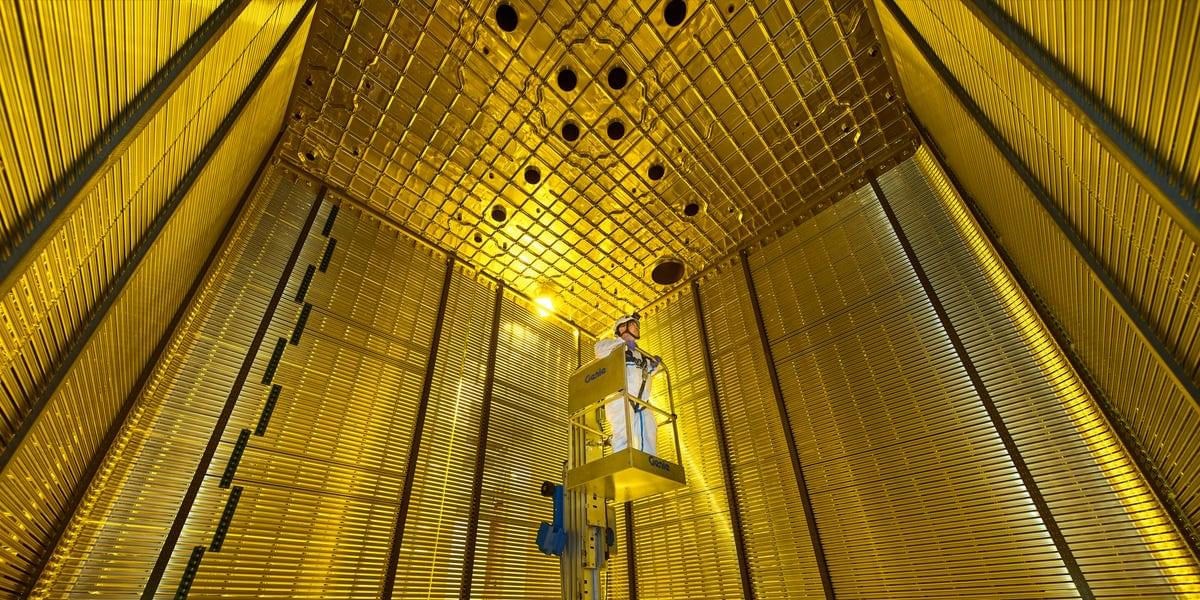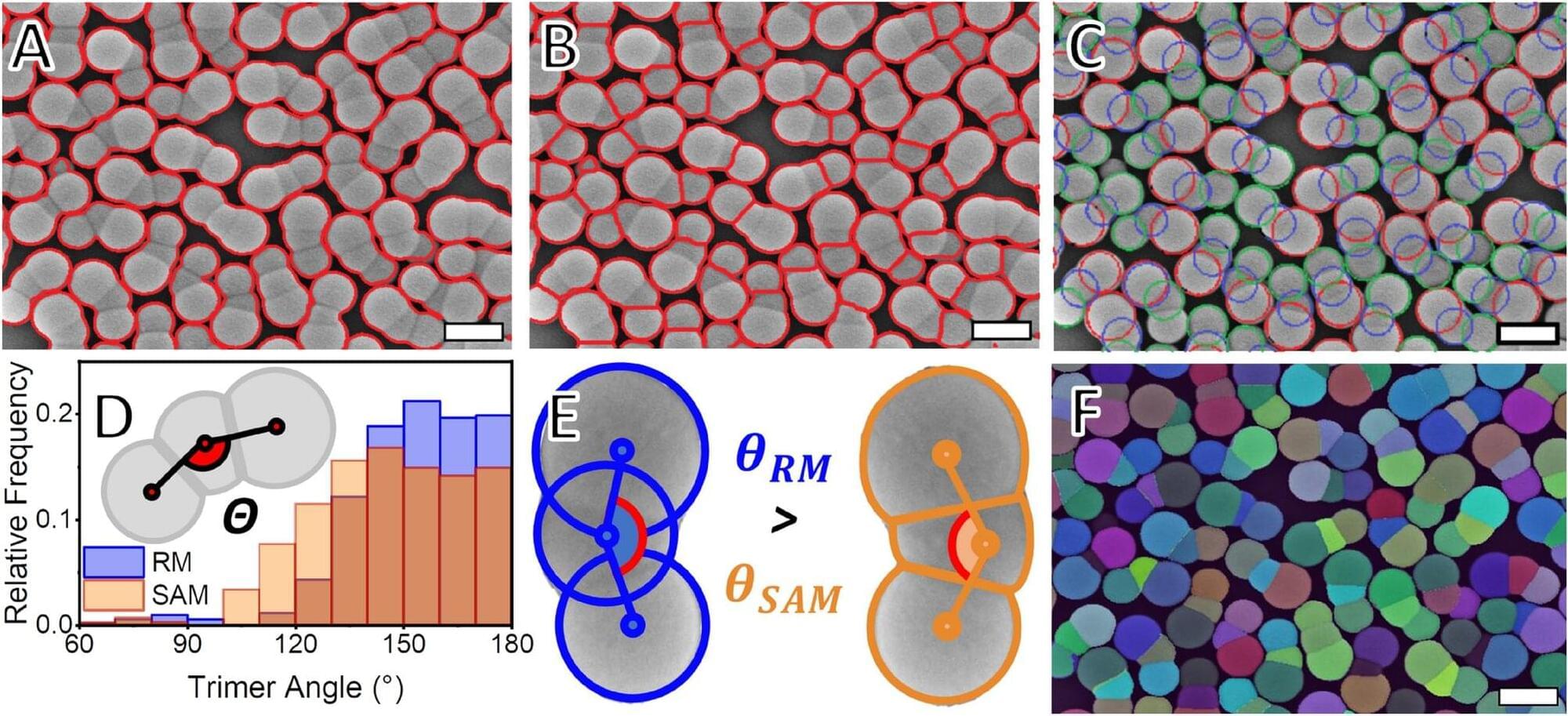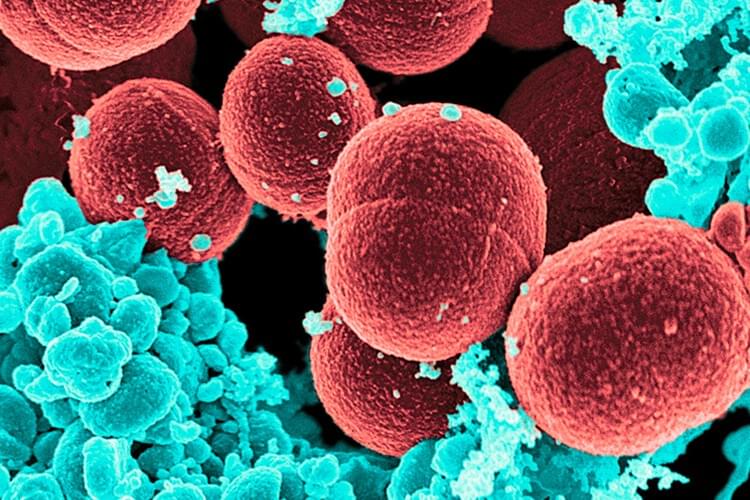With the help of shape-shifting ghost particles, ‘DUNE’ could unlock all-new physics.



Nanoparticle researchers spend most of their time on one thing: counting and measuring nanoparticles. Each step of the way, they have to check their results. They usually do this by analyzing microscopic images of hundreds of nanoparticles packed tightly together. Counting and measuring them takes a long time, but this work is essential for completing the statistical analyses required for conducting the next, suitably optimized nanoparticle synthesis.
Alexander Wittemann is a professor of colloid chemistry at the University of Konstanz. He and his team repeat this process every day. “When I worked on my doctoral thesis, we used a large particle counting machine for these measurements. It was like a cash register, and, at the time, I was really happy when I could measure three hundred nanoparticles a day,” Wittemann remembers.
However, reliable statistics require thousands of measurements for each sample. Today, the increased use of computer technology means the process can move much more rapidly. At the same time, the automated methods are very prone to errors, and many measurements still need to be conducted, or at least double-checked, by the researchers themselves.

Lithium nickel oxide (LiNiO2) has emerged as a potential new material to power next-generation, longer-lasting lithium-ion batteries. Commercialization of the material, however, has stalled because it degrades after repeated charging.
University of Texas at Dallas researchers have discovered why LiNiO2 batteries break down, and they are testing a solution that could remove a key barrier to widespread use of the material. They published their findings in the journal Advanced Energy Materials.
The team plans first to manufacture LiNiO2 batteries in the lab and ultimately to work with an industry partner to commercialize the technology.


https://www.youtube.com/@The.AI.podcasts.
AI, Deep Dive, spacetime inertia, unified energy framework, gravity, dark matter, dark energy, black holes, emergent gravity, energy inertia, mass-energy interactions, missing mass problem, cosmic expansion, event horizon mechanics, Einstein’s General Relativity, spacetime curvature, galactic rotation curves, quantum field theory, spacetime as energy, energy resistance, inertial effects, graviton alternative, energy density distribution, inverse-square law, gravitational lensing, galactic halos, high-energy cosmic regions, X-ray emissions, electromagnetic fields, cosmological constant, accelerating universe, large-scale inertia, spacetime resistance, event horizon physics, singularity alternatives, James Webb Space Telescope, early galaxy formation, modified gravity, inertia-driven cosmic expansion, energy saturation point, observational cosmology, new physics, alternative gravity models, astrophysical testing, theoretical physics, unification of forces, experimental validation, fundamental physics revolution, black hole structure, cosmic energy fields, energy gradient effects, resistance in spacetime, extreme energy zones, black hole event horizons, quantum gravity, astrophysical predictions, future space observations, high-energy astrophysics, cosmic structure formation, inertia-based galaxy evolution, spacetime fluid dynamics, reinterpreting physics, mass-energy equivalence.
Description:
In this deep dive into the nature of gravity, dark matter, and dark energy, we explore a groundbreaking hypothesis that could revolutionize our understanding of the universe. What if gravity is not a fundamental force but an emergent property of spacetime inertia? This novel framework, proposed by Dave Champagne, reinterprets the role of energy and inertia within the fabric of the cosmos, suggesting that mass-energy interactions alone can account for gravitational effects—eliminating the need for exotic matter or hypothetical dark energy forces.
We begin by examining the historical context of gravity, from Newton’s classical mechanics to Einstein’s General Relativity. While these theories describe gravitational effects with incredible accuracy, they still leave major mysteries unsolved, such as the unexplained motions of galaxies and the accelerating expansion of the universe. Traditionally, these anomalies have been attributed to dark matter and dark energy—hypothetical substances that have yet to be directly observed. But what if there’s another explanation?
By treating spacetime itself as an energy field with intrinsic inertia, we propose that gravitational effects arise naturally from the resistance of this energy to changes in motion. Just as mass resists acceleration due to inertia, energy may also exhibit resistance at cosmic scales, leading to effects that mimic gravity, dark matter, and dark energy. This perspective offers a fresh way to interpret the missing mass problem, suggesting that the high-energy environments surrounding galaxies create inertia effects that explain their rotational speeds—without requiring an invisible mass component.
We explore how this framework extends to cosmic expansion. Instead of postulating an unknown repulsive force (dark energy), spacetime inertia may drive the acceleration of the universe as a natural consequence of energy distribution at vast scales. Could this be an alternative to Einstein’s cosmological constant? We analyze how large-scale resistance effects could account for the observations of an accelerating cosmos.
Quantum computing is an alternative computing paradigm that exploits the principles of quantum mechanics to enable intrinsic and massive parallelism in computation. This potential quantum advantage could have significant implications for the design of future computational intelligence systems, where the increasing availability of data will necessitate ever-increasing computational power. However, in the current NISQ (Noisy Intermediate-Scale Quantum) era, quantum computers face limitations in qubit quality, coherence, and gate fidelity. Computational intelligence can play a crucial role in optimizing and mitigating these limitations by enhancing error correction, guiding quantum circuit design, and developing hybrid classical-quantum algorithms that maximize the performance of NISQ devices. This webinar aims to explore the intersection of quantum computing and computational intelligence, focusing on efficient strategies for using NISQ-era devices in the design of quantum-based computational intelligence systems.
Speaker Biography:
Prof. Giovanni Acampora is a Professor of Artificial Intelligence and Quantum Computing at the Department of Physics “Ettore Pancini,” University of Naples Federico II, Italy. He earned his M.Sc. (cum laude) and Ph.D. in Computer Science from the University of Salerno. His research focuses on computational intelligence and quantum computing. He is Chair of the IEEE-SA 1855 Working Group, Founder and Editor-in-Chief of Quantum Machine Intelligence. Acampora has received multiple awards, including the IEEE-SA Emerging Technology Award, IBM Quantum Experience Award and Fujitsu Quantum Challenge Award for his contributions to computational intelligence and quantum AI.
https://chatgpt.com/share/67aa58eb-452c-8011-a942-a4a084a17f23
The recent development of AI presents challenges, but also great opportunities.
Want to attend the Demysticon Conference? Go to https://demystifysci.com/demysticon-2025
Mind also my backup channel:
https://odysee.com/@TheMachian: c.
My books: www.amazon.com/Alexander-Unzicker/e/B00DQCRYYY/
Get a Wonderful Person Tee: https://teespring.com/stores/whatdamath.
More cool designs are on Amazon: https://amzn.to/3QFIrFX
Alternatively, PayPal donations can be sent here: http://paypal.me/whatdamath.
Hello and welcome! My name is Anton and in this video, we will talk about the discovery of the most massive superstructure in the nearby universe — Quipu.
https://arxiv.org/abs/2501.19236
Bohringer et al., Astronomy and Astrophysics, 2025
https://en.wikipedia.org/wiki/Sachs%E2%80%93Wolfe_effect.
Similar videos:
https://youtu.be/wp8zHG1g7bc.
#quipu #superstructure #cosmos.
0:00 Largest superstructure in the universe — Quipu.
0:45 Laniakea discovery of 2014
1:25 Shapley concentration.
2:35 Cosmological issues: Hubble Tension and S8 tension.
3:45 New study mapping galaxies and the discovery.
5:15 Additional findings and implications.
6:25 What is this though?
7:20 Confirming predictions and how this was found.
8:40 What’s next?
Support this channel on Patreon to help me make this a full time job:
https://www.patreon.com/whatdamath.
Bitcoin/Ethereum to spare? Donate them here to help this channel grow!
bc1qnkl3nk0zt7w0xzrgur9pnkcduj7a3xxllcn7d4
or ETH: 0x60f088B10b03115405d313f964BeA93eF0Bd3DbF
Space Engine is available for free here: http://spaceengine.org.
🚀 Scientists have confirmed a super-Earth in the habitable zone! HD 20,794D, located just 20 light-years away, could have liquid water, making it a prime candidate for life. But its elliptical orbit raises big questions—could life survive its extreme temperature swings? 🌍 With future telescopes set to analyze its atmosphere, we may be on the verge of a historic discovery. Watch now to explore what makes HD 20,794D so special! Subscribe for more space discoveries! 🌌✨
Paper link: https://www.aanda.org/articles/aa/ful… 00:00 Introduction 00:41 Discovery and Confirmation Process 02:13 Characteristics of HD 20,794D 04:43 Implications for Habitability and Future Research 08:38 Outro 09:07 Enjoy MUSIC TITLE : Starlight Harmonies MUSIC LINK : https://pixabay.com/music/pulses-star… Visit our website for up-to-the-minute updates: www.nasaspacenews.com Follow us Facebook: / nasaspacenews Twitter:
/ spacenewsnasa Join this channel to get access to these perks:
/ @nasaspacenewsagency #NSN #NASA #Astronomy#HD20794D #Exoplanet #SuperEarth #NASA #SpaceExploration #AlienLife #HabitableZone #EarthLikePlanet #Astronomy #Astrobiology #LifeOnOtherPlanets #ExoplanetDiscovery #SpaceNews #AstronomyLovers #Telescope #PlanetHunting #NewEarth #DeepSpace #JWST #HabitableExoplanets #ScienceNews #FutureOfSpace #NASAUpdates #ExtremePlanets #SpaceFacts #AstronomyCommunity #SpaceTech #SolarSystem #GalaxiesBeyond #AlienWorld.
Chapters:
00:00 Introduction.
00:41 Discovery and Confirmation Process.
02:13 Characteristics of HD 20,794D.
04:43 Implications for Habitability and Future Research.
08:38 Outro.
09:07 Enjoy.
MUSIC TITLE : Starlight Harmonies.
MUSIC LINK : https://pixabay.com/music/pulses-star…
Visit our website for up-to-the-minute updates: